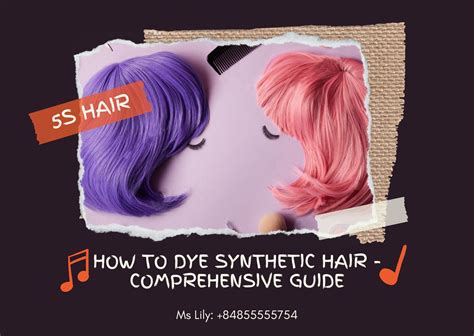Introduction
Synthetic hair dye has revolutionized the hair coloring industry, offering endless possibilities for customization and self-expression. With over 1 billion people coloring their hair worldwide and a global market size exceeding $5 billion, it’s no wonder that synthetic hair dyes have become an integral part of modern beauty routines.

Benefits of Synthetic Hair Dye
Synthetic hair dyes provide numerous benefits over natural dyes, including:
- Vibrant and Long-Lasting Colors: Synthetic dyes create intense, vibrant shades that resist fading and maintain their color over time.
- Wide Color Range: Synthetic dyes offer an extensive spectrum of colors, from classic shades to bold and fashion-forward hues.
- Ease of Use: Synthetic hair dyes are available in various forms, from creamy formulas to gels and sprays, making them easy to apply at home or in salons.
- Damage Reduction: Synthetic hair dyes have advanced in recent years, minimizing damage to hair compared to older formulas.
Types of Synthetic Hair Dye
There are several types of synthetic hair dyes based on their chemical composition:
- Permanent Dyes: These dyes penetrate the hair shaft and alter the natural pigment, resulting in permanent color changes.
- Semi-Permanent Dyes: Semi-permanent dyes deposit color on the hair’s surface without altering the natural pigment. These dyes typically last 6-12 washes.
- Demi-Permanent Dyes: Demi-permanent dyes are less intense than permanent dyes and provide color that lasts for 20-25 washes.
- Temporary Dyes: Temporary dyes apply color to the hair’s exterior without penetrating the shaft. These dyes wash out in a single wash.
Ingredients and Safety Considerations
Synthetic hair dyes contain various ingredients, including:
- Color Pigments: These pigments add color to the hair. Common pigments include azo dyes, anthraquinone dyes, and nitro dyes.
- Oxidizing Agents: Oxidizing agents, such as hydrogen peroxide, lighten the hair’s natural pigment to allow the dye to penetrate.
- Alcohols and Thickeners: These ingredients provide consistency and spreadability to the dye formula.
Safety Considerations:
While synthetic hair dyes are generally safe to use, some individuals may experience allergic reactions or skin irritation. Always perform a patch test on a small area of skin before applying the dye to the entire head. Pregnant or breastfeeding women should consult a healthcare professional before using hair dye.
Application Techniques
Applying synthetic hair dye requires careful techniques to achieve desired results:
- Read Instructions Carefully: Follow the instructions provided with the hair dye to ensure proper application and development time.
- Prepare Hair: Wash hair thoroughly with clarifying shampoo to remove any product buildup. Towel-dry hair until it is damp.
- Apply Dye: Apply the hair dye evenly throughout the hair using a brush or applicator.
- Development Time: Allow the dye to develop for the recommended time, typically 30-45 minutes.
- Rinse and Condition: Rinse out the hair dye thoroughly with cool water and apply conditioner to nourish and seal in the color.
Trends and Innovations
The synthetic hair dye industry is constantly evolving, with new trends and innovations emerging:
- Balayage: Balayage is a freehand hair coloring technique that creates natural-looking highlights.
- Ombre: Ombre is a gradual transition from one color to another, creating a blended and subtle effect.
- Pastel Shades: Pastel shades, such as lavender, pink, and blue, have become increasingly popular for both fashion-forward and everyday looks.
- Natural and Organic Dyes: There is a growing demand for natural and organic hair dyes that are free from harmful chemicals.
Future Applications: Dychromic Hair Technology
Dychromic hair technology is an emerging field that explores the use of stimuli-responsive materials to create hair dyes that change color in response to external cues, such as light, heat, or pH. This technology has potential applications in fashion, hair styling, and even medical diagnostics.
Tables
| Type of Hair Dye | Longevity | Intensity | Damage |
|---|---|---|---|
| Permanent | >20 washes | Intense | Medium |
| Semi-Permanent | 6-12 washes | Moderate | Low |
| Demi-Permanent | 20-25 washes | Medium | Low |
| Temporary | 1 wash | Light | None |
| Hair Dye Ingredient | Purpose |
|---|---|
| Color Pigments | Add color |
| Oxidizing Agents | Lighten natural pigment |
| Alcohols | Assist spreading |
| Thickeners | Improve consistency |
| Trendy Hair Coloring Techniques | Description |
|---|---|
| Balayage | Freehand highlights |
| Ombre | Gradual color transition |
| Pastel Shades | Soft and muted hues |
| Natural and Organic Dyes | Chemical-free hair dyes |
| Tips for Applying Synthetic Hair Dye | Description |
|---|---|
| Read instructions carefully | Follow for optimal results |
| Prepare hair properly | Remove buildup |
| Apply dye evenly | Ensure thorough coverage |
| Allow for proper development time | Let dye penetrate |
| Rinse and condition | Remove dye and nourish hair |
Conclusion
Synthetic hair dye has revolutionized the world of hair coloring, providing endless possibilities for self-expression and creativity. With a wide range of colors, techniques, and innovations, synthetic hair dye allows individuals to transform their appearance, experiment with new looks, and embrace their own unique styles.
